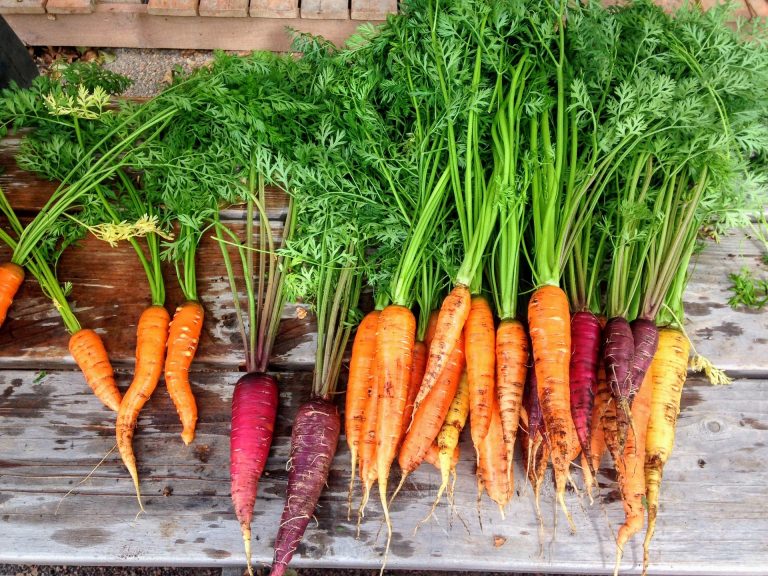Carrot: Botanical Insights, Nutritional Benefits, and Culinary Uses
Introduction
The carrot, scientifically known as Daucus carota, is a widely cultivated root vegetable cherished for its vibrant color, sweet flavor, and nutritional richness. Originating in Central Asia and domesticated over millennia, carrots have become a staple in diets worldwide, valued not only for their culinary versatility but also for their health-promoting properties. This article delves into the botanical characteristics of carrots, their nutritional benefits, culinary uses across cultures, and their significance in agriculture and health.

Botanical Characteristics of Carrots
Carrots belong to the Apiaceae family, which includes other familiar vegetables such as celery and parsley. Here are the key botanical features of carrots:
- Plant Morphology: Carrot plants are biennial, producing a rosette of leaves in the first year and a flowering stem in the second year. The leaves are finely divided and fern-like, growing from a thick, fleshy taproot—the edible part of the plant that stores nutrients.
- Root Structure: The carrot root varies in size, shape, and color depending on the cultivar. It typically ranges from cylindrical to conical, with a smooth or slightly textured surface. Carrots can be orange, purple, yellow, white, or red, reflecting their diverse genetic heritage.
- Flowering and Seed Production: In the second year of growth, carrot plants produce compound umbels of small white or yellow flowers. These flowers attract pollinators such as bees and butterflies, facilitating seed formation. Carrot seeds are tiny and elongated, commonly used for cultivation and breeding purposes.
- Growing Conditions: Carrots thrive in cool climates with well-drained, sandy loam soil. Carrots prefer full sunlight but also can tolerate partial shade. Carrots are typically grown from seeds directly sown into the soil, requiring consistent moisture for germination and root development.
Nutritional Benefits of Carrots
Carrots are celebrated for their nutritional density and health-promoting compounds, making them a valuable addition to a balanced diet:
- Vitamins and Minerals: Carrots are an excellent source of vitamin A, providing beta-carotene—a precursor that converts to retinol in the body. Vitamin A is very essential for vision, immunity, and healthy skin. Carrots also contain vitamins C, E, and K, along with minerals such as potassium, manganese, and folate.
- Antioxidant Properties: Carrots are rich in antioxidants, including beta-carotene, alpha-carotene, and lutein. These compounds help neutralize free radicals, reducing oxidative stress and inflammation associated with chronic diseases like heart disease and cancer.
- Dietary Fiber: Carrots are a good source of dietary fiber, which supports digestive health by promoting regular bowel movements and aiding in the maintenance of healthy gut bacteria.
- Low in Calories: Despite their sweetness, carrots are relatively low in calories, making them a nutrient-dense option for weight management and overall health.
- Cardiovascular Health: The potassium and fiber in carrots contribute to cardiovascular health by helping to regulate blood pressure and cholesterol levels. Consuming carrots regularly may reduce the risk of heart disease and stroke.

Bioactive Compounds in Carrots
Beyond their essential nutrients, carrots contain bioactive compounds with potential health benefits:
- Carotenoids: Beta-carotene, alpha-carotene, and lutein are carotenoids found in carrots, known for their antioxidant and anti-inflammatory properties. These compounds support eye health, skin protection, and immune function.
- Polyacetylenes: Carrots contain polyacetylenes such as falcarinol and falcarindiol, which have been studied for their potential anticancer effects. These compounds may inhibit the growth of cancer cells and promote apoptosis (cell death) in vitro.
3. Phenolic Compounds: Phenolic acids and flavonoids in carrots contribute to their antioxidant activity and may offer protective effects against chronic diseases, including cardiovascular disorders and neurodegenerative conditions.
Culinary Uses of Carrots
Carrots are prized for their versatility in culinary applications, enhancing dishes with their sweet, earthy flavor and vibrant color:
- Raw Consumption: Raw carrots are commonly enjoyed as snacks, either whole or sliced, and served with dips or hummus. Grated carrots are used in salads and coleslaws, adding crunch and sweetness.
- Cooked Dishes: Carrots are a staple ingredient in soups, stews, and casseroles, where they impart flavor and texture. They can be roasted, steamed, or sautéed to enhance their natural sweetness and caramelization.
- Juices and Smoothies: Carrot juice is a popular beverage, often combined with other fruits and vegetables for added flavor and nutrition. Carrots blend well in smoothies, providing a natural sweetness and vibrant color.
- Baked Goods: Carrots are a key ingredient in baking, particularly in cakes, muffins, and quick breads such as carrot cake and carrot muffins. Grated carrots add moisture and sweetness to baked goods while contributing to their nutritional value.
- Preserves and Pickles: Carrots can be preserved through pickling or fermentation, retaining their crisp texture and tangy flavor. Pickled carrots are used as condiments or accompaniments to savory dishes.

Cultural Significance of Carrots
Carrots hold cultural significance in various societies, influencing culinary traditions, folklore, and agricultural practices:
- Historical and Folklore References: Carrots have a rich history dating back to ancient civilizations, where they were cultivated for their medicinal properties and culinary uses. In European folklore, carrots were associated with fertility and protection against evil spirits.
- Culinary Traditions: Carrots feature prominently in global cuisines, adapting to regional ingredients and cooking techniques. In Eastern cuisines such as Indian and Middle Eastern, carrots are used in savory dishes, desserts, and beverages.
- Symbolism and Festivals: Carrots may symbolize prosperity, longevity, or good fortune in certain cultures, leading to their inclusion in celebrations, rituals, and festivals.
- Agricultural Heritage: Carrot cultivation has shaped agricultural landscapes and farming practices worldwide, with heirloom varieties preserved for their unique flavors and cultural significance.
Future Directions in Carrot Research
As interest in sustainable agriculture, nutrition, and food security grows, ongoing research in carrots focuses on:
- Genetic Diversity and Breeding: Studying and conserving genetic diversity in carrot cultivars to enhance resilience to pests, diseases, and climate change. Breeding programs aim to develop carrots with improved yield, flavor, and nutritional profiles.
- Nutritional Enhancement: Investigating biofortification strategies to increase the content of vitamins, antioxidants, and phytochemicals in carrots, addressing global nutrition deficiencies.
- Sustainable Production: Implementing sustainable farming practices, such as organic cultivation, integrated pest management, and soil conservation, to minimize environmental impact and promote agroecological resilience.
- Health Applications: Exploring the potential health benefits of carrot bioactive compounds in preventing chronic diseases, supporting immune function, and promoting overall well-being.

Conclusion
In conclusion, carrots exemplify the intersection of botanical diversity, nutritional value, and cultural significance, embodying their role as a versatile and beneficial root vegetable. From their origins in Central Asia to global culinary adoption and scientific research, carrots continue to captivate and contribute to human well-being. As research advances in an era of sustainability and health awareness, carrots remain a promising subject for interdisciplinary inquiry, offering insights into agriculture, nutrition, medicine, and cultural heritage. Embracing the multifaceted nature of carrots ensures their enduring presence as a symbol of vitality, flavor, and tradition in the global culinary landscape. Whether enjoyed raw, cooked, or preserved, carrots continue to inspire creativity and nourish communities worldwide.

